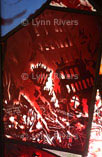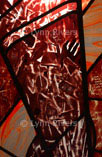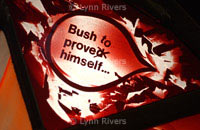
Visual Themes
|
1. The Buildings and their Structure
|
Words
Words have been used in various ways in Moment of Impact 9/11, from these I outline six aspects.
1. Scale
Words were used to help convey notions of scale. For instance, the huge scale of the buildings that were destroyed compared to the individual human. A number of viewers have commented on, and expressed relief, when they found the hand-scribbled words in the ruins of the Twin Towers in Panel 9. Another example is the large AM! which emphasises that 9/11 was no ordinary morning. This is itself surrounded by all the other glass to emphasise the scale of the things that took place at that time. It only deals with a very small part of 9/11 let alone its future impacts with their individual and global consequences. Other words referring to the start of the working day are present at a smaller scale in other panels.
 |
 |
| Panel 9 | Panel 6 |
The words are used in combination with the colour of the blue sky to indicate what seemed like the start of a good working day. What unfolded is referred to by the use of other combinations of blue flashed glass and other flashed colours with abstract types of glass.
2. Word Manipulation
The significance of the splitting of whaam! into two, which instigated this work, is discussed in the Story of the Work.
Immediately after the attacks, messages to thank the emergency workers to expressions of the defiant American spirit, as well as reactions to those who were thought to have carried out the attacks, were written in the dust and debris of the Twin Towers. Courage was undeniably what the survivors, the rescue workers, and the victims’ families demonstrated and would continue to need. I continued the wordplay as can be seen, for example at the top of Panel 2, where the word ‘courage’ was put into the spikes of the Statue of Liberty and split into ‘c-our-rage’. This reflected my thoughts during the night of 9/11 when I wondered what the fear would be like in New York City, what apocalyptic event might have occurred by the time I awoke? How quickly would America militarily retaliate? Would they retaliate? Could they resist, was there another option?
 |
| Panel 2 |
3. Complexities
There were many aspects I would have liked to have explored in greater depth but due to their complexity they would have warranted a far greater space than I deemed available. One priority, that had to be solved, was the major reference to the TV media on 9/11, which occurs in the top of Panel 2.
I decided to portray the façade of live TV, the end and public part of the complex media processes. (more...) Instead of using the formal graphics of news production, I chose to make images of the TV appear in a band in the crown of the Statute of Liberty. The words ‘live TV’ were produced not with typical typefaces but with the handwritten words. This choice was made because of the proximity of the presenters who ‘seemed’ closer, their human concerns were more evident, in spite of the professional façade they presented. They appeared more alive than I recall in any other disaster. But in contrast the actual personalities producing the news seemed unimportant compared to 9/11. Hence I made the news presenters appear as silhouettes, but not black and white, but in blue against a colour to indicate the artificial light of a studio. After all, they were supposedly safe in their studios unlike the news crews reporting from the streets of the city. Typical journalistic questions are also included in this area to indicate aspects of the media language.
4. Visualising the Unseen & Immediate Communications
The ability to communicate via mobile phones has changed the amount and speed at which information is exchanged during disasters. The recipient is closer in time to the disaster than previously possible. (9/11 occurred before phone picture messaging had become commonplace.) I wanted to indicate, in Panel 1, the need to communicate instantly in the context of the chaos in a descending plane. The immediacy of personal communications that were made was also reflected in the choice of using handwriting rather than any specific typeface that the phone companies offer.
 |
| Panel 1 |
5. Repetition
The fact that the attacks happened in the morning is referred to in a number of places. There is a link from Panel 6 to Panel 7 where the words AM from whaam! is further developed in a reference to a TV monitor or a computer; this is deliberately vague. ‘Good morn’, which sounds like ‘Good mourn’, with the ‘ing’ broken away from the screen on a shard.
 |
 |
| Panel 6 | Panel 7 |
6. No Portraits
There were certain things I didn’t wish to visualise. I specifically didn’t want to make portraits of the Mayor, the President or Father Mychal. It would miss the point and cause more problems than it solved. In Panel 9 in amongst the collapsing buildings I included a small number of speech bubbles. They were developed in response to trying to deal with the daily changing news. I wanted to point out that future history would continue to judge certain individuals, but also bearing in mind that I needed to work as succinctly as possible in terms of space.
All the speech bubbles started from the thought ‘…proved himself (or) themselves’. In the bubble about Bush in Panel 9 the crossing out of the ‘d’ in proved and the addition of the word ‘to’ refers to three moments of time. The stature of the President was judged by his initial response, and in particular his defiant speech from the ruins of 9/11 via my TV, and his actions are being judged now and will be in the future.
 |
| Panel 9 |
If you are interested to find out more, please contact the artist
Moment of Impact 9/11 is now seeking a permanent home contact us.